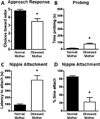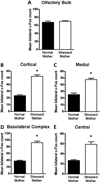Developing a neurobehavioral animal model of infant attachment to an abusive caregiver
- PMID: 20163787
- PMCID: PMC3929962
- DOI: 10.1016/j.biopsych.2009.12.019
Developing a neurobehavioral animal model of infant attachment to an abusive caregiver
Abstract
Background: Both abused and well cared for infants show attachment to their caregivers, although the quality of that attachment differs. Moreover, the infant's attachment to the abusive caregiver is associated with compromised mental health, especially under stress. In an attempt to better understand how abuse by the caregiver can compromise mental health, we explore the neural basis of attachment in both typical and abusive environments using infant rats, which form attachments to the mother through learning her odor. Here, we hypothesize that the neural circuitry for infant attachment differs based on the quality of the attachment, which can be uncovered during stressful situations.
Methods: We used infant rats to compare infant attachment social behaviors and supporting neurobiology using natural maternal odor, as well as two odor-learning attachment paradigms: odor-stroke (mimics typical attachment) and odor-.5 mA shock conditioning (mimics abusive attachment). Next, to uncover differences in behavior and brain, these pups were injected with systemic corticosterone. Finally, pups were reared with an abusive mother to determine ecological relevance.
Results: Our results suggest that the natural and learned attachment odors indistinguishably control social behavior in infancy (approach to the odor and interactions with the mother). However, with corticosterone injection, pups with an abusive attachment show disrupted infant social behavior with the mother and engagement of the amygdala.
Conclusions: This animal model of attachment accommodates both abusive and typical attachment and suggests that pups' social behavior and underlying neural circuitry may provide clues to understanding attachment in children with various conditions of care.
Conflict of interest statement
The authors report no biomedical financial interests or potential conflicts of interest.
Figures






Similar articles
-
Dual circuitry for odor-shock conditioning during infancy: corticosterone switches between fear and attraction via amygdala.J Neurosci. 2006 Jun 21;26(25):6737-48. doi: 10.1523/JNEUROSCI.0499-06.2006. J Neurosci. 2006. PMID: 16793881 Free PMC article.
-
Memory of early maltreatment: neonatal behavioral and neural correlates of maternal maltreatment within the context of classical conditioning.Biol Psychiatry. 2005 Apr 15;57(8):823-31. doi: 10.1016/j.biopsych.2005.01.032. Biol Psychiatry. 2005. PMID: 15820702
-
Paradoxical neurobehavioral rescue by memories of early-life abuse: the safety signal value of odors learned during abusive attachment.Neuropsychopharmacology. 2015 Mar;40(4):906-14. doi: 10.1038/npp.2014.266. Epub 2014 Oct 6. Neuropsychopharmacology. 2015. PMID: 25284320 Free PMC article.
-
The development and neurobiology of infant attachment and fear.Dev Neurosci. 2012;34(2-3):101-14. doi: 10.1159/000336732. Epub 2012 May 8. Dev Neurosci. 2012. PMID: 22571921 Free PMC article. Review.
-
Neurobiology of attachment to an abusive caregiver: short-term benefits and long-term costs.Dev Psychobiol. 2014 Dec;56(8):1626-34. doi: 10.1002/dev.21219. Epub 2014 Apr 25. Dev Psychobiol. 2014. PMID: 24771610 Free PMC article. Review.
Cited by
-
Developmental neurobiology of the rat attachment system and its modulation by stress.Behav Sci (Basel). 2012 Jun 1;2(2):79-102. doi: 10.3390/bs2020079. Behav Sci (Basel). 2012. PMID: 23626910 Free PMC article.
-
Somatoform pain: a developmental theory and translational research review.Psychosom Med. 2012 Sep;74(7):717-27. doi: 10.1097/PSY.0b013e3182688e8b. Epub 2012 Aug 28. Psychosom Med. 2012. PMID: 22929064 Free PMC article. Review.
-
FAAH Inhibition Restores Early Life Stress-Induced Alterations in PFC microRNAs Associated with Depressive-Like Behavior in Male and Female Rats.Int J Mol Sci. 2022 Dec 17;23(24):16101. doi: 10.3390/ijms232416101. Int J Mol Sci. 2022. PMID: 36555739 Free PMC article.
-
From resilience to vulnerability: mechanistic insights into the effects of stress on transitions in critical period plasticity.Front Psychiatry. 2013 Aug 13;4:90. doi: 10.3389/fpsyt.2013.00090. eCollection 2013. Front Psychiatry. 2013. PMID: 23964249 Free PMC article.
-
Development of individual differences in stress responsiveness: an overview of factors mediating the outcome of early life experiences.Psychopharmacology (Berl). 2011 Mar;214(1):141-54. doi: 10.1007/s00213-010-2118-y. Epub 2010 Dec 18. Psychopharmacology (Berl). 2011. PMID: 21165737 Free PMC article. Review.
References
-
- Carlson V, Cicchetti D, Barnett D, Braunwald K. Finding order in disorganization: Lessons from research on maltreated infant’s attachment to their caregivers. In: Cicchetti D, Carlson V, editors. Child Maltreatment: Theory and Research on the Causes and Consequences of Child Abuse and Neglect. New York: Cambrige University Press; 1989. pp. 494–528.
-
- Bremner JD. Long-term effects of childhood abuse on brain and neurobiology. Child Adolesc Psychiatr Clin N Am. 2003;12:271–292. - PubMed
-
- Gunnar MR. Integrating neuroscience and psychological approaches in the study of early experiences. Ann N Y Acad Sci. 2003;1008:238–247. - PubMed
-
- Heim C, Nemeroff CB. The role of childhood trauma in the neurobiology of mood and anxiety disorders: Preclinical and clinical studies. Biol Psychiatry. 2001;49:1023–1039. - PubMed
-
- Teicher MN, Andersen SL, Polcari A, Andersen CM, Navalta CP, Kim DM. The neurobiological consequences of early stress and childhood maltreatment. Neurosci Biobehav Rev. 2003;27:33–44. - PubMed
Publication types
MeSH terms
Substances
Grants and funding
LinkOut - more resources
Full Text Sources
Medical

